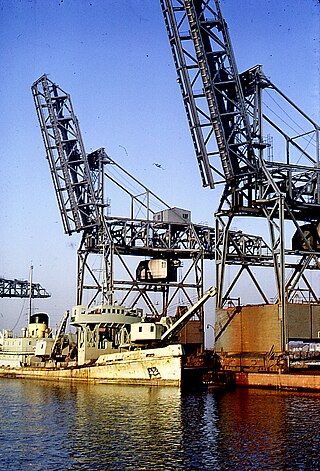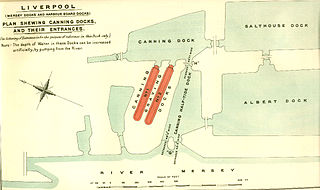
Alexandra Dock is a dock on the River Mersey, England, and part of the Port of Liverpool. It is situated in the northern dock system in Bootle. Alexandra Dock consists of a main basin nearest the river wall and three branch docks to the east, with the southern branch mostly filled in.

Langton Dock is a dock on the River Mersey, England, and part of the Port of Liverpool. It is situated in the northern dock system in Bootle, connected to Alexandra Dock to the north and Brocklebank Dock to the south. Langton Dock locks provide a working connection to the river; one of the two remaining operational river entrances in the northern dock system.

Brocklebank Dock is a dock on the River Mersey, England, and part of the Port of Liverpool. It is situated in the northern dock system in Bootle, connected to Langton Dock to the north and Canada Dock to the south. Carriers' Dock was originally sited to the east.

Collingwood Dock is a dock on the River Mersey, in England, and part of the Port of Liverpool. It is situated in the northern dock system in Vauxhall, and is connected to Stanley Dock to the east and Salisbury Dock to the west.

Victoria Dock was a dock on the River Mersey, England, and part of the Port of Liverpool. Situated in the northern dock system, it was connected to Trafalgar Dock to the north and West Waterloo Dock to the south.

Prince's Dock is a dock on the River Mersey, England, and part of the Port of Liverpool. It is the most southerly of the docks situated in the northern part of the Liverpool dock system, connected to Prince's Half-Tide Dock to the north. The dock is now in the buffer zone to one of Liverpool's World Heritage Sites.

Canning Dock on the River Mersey is part of the Port of Liverpool in northern England. The dock is in the southern dock system, connected to Salthouse Dock to the south and with access to the river via the Canning Half Tide Dock to the west. The Canning Graving Docks are accessed from the dock.

Salthouse Dock is a dock on the River Mersey, England, and part of the Port of Liverpool. It is situated in the southern dock system, connected to Canning Dock to the north, Wapping Dock via Wapping Basin to the south and Albert Dock to the west.

Brunswick Dock is a dock on the River Mersey, in England, and part of the Port of Liverpool. It is situated in the southern dock system, connected to Coburg Dock to the north, Toxteth Dock to the south.

Harrington Dock was a dock on the River Mersey and part of the Port of Liverpool. Situated in the southern dock system, it was connected to Toxteth Dock to the north and Herculaneum Dock to the south.

Carriers' Dock was a dock on the River Mersey, England, and part of the Port of Liverpool. The dock was situated in the northern dock system and connected to Brocklebank Dock to the west.

The Great Float is a body of water on the Wirral Peninsula, England, formed from the natural tidal inlet, the Wallasey Pool. It is split into two large docks, East Float and West Float, both part of the Birkenhead Docks complex. The docks run approximately 2 miles (3 km) inland from the River Mersey, dividing the towns of Birkenhead and Wallasey. The Great Float consists of 110 acres (45 ha) of water and more than 4 miles (6 km) of quays.

Morpeth Dock is a dock at Birkenhead, Wirral Peninsula, England. The dock is situated between the River Mersey and Egerton Dock.

Alfred Dock is a dock at Birkenhead, Merseyside, England. The dock covers an area of 8 acres (32,000 m2) and provides access to the Great Float from the River Mersey.

Vittoria Dock is a dock in Birkenhead, Wirral Peninsula, England. It was built between 1904 and 1908, from land reclaimed during the construction of the Great Float.

Bidston Dock was a dock at Birkenhead, in England. It was situated to the west of the Great Float, between Bidston and Poulton.

The Wallasey Dock, was a dock at Birkenhead, Wirral Peninsula, England. The dock was accessed via East Float to the west, until Wallasey Dock was filled at the turn of the millennium.
Wallasey Pool was a natural tidal inlet of water that separated the towns of Wallasey and Birkenhead on the Wirral Peninsula, England. Originally flowing directly into the River Mersey, it was converted into the sophisticated Birkenhead Dock system from the 1820s onwards by land reclamation, with the main portion of the pool becoming known as the Great Float. In 1933, with the exception of a small lake, the head of Wallasey Pool at Poulton was converted into Bidston Dock. By 2003, this dock had been filled in.

Birkenhead Dock Branch is a disused railway line running from the South junction of Rock Ferry, to the site of the former Bidston Dock on the Wirral Peninsula, England. The branch is approximately 4+1⁄2 miles (7.2 km) in length. Although called a branch, the line was accessible from both ends, from Bidston East junction and from Rock Ferry railway station. The former Mollington Street Rail Depot was branched into the line. A section of the line runs through Haymarket Tunnel and a low-level cutting through the centre of Birkenhead; visible from the road flyovers. The former Canning Street North signal box has now been demolished following fire damage, and the rails across the level crossing there have been removed due to the provision of cycle lanes on the roadway. The non-standard gates remain on the east side, but a fence has been erected on the other side despite the railway being officially out of use, rather than closed. Level crossings are also located at Duke Street and Wallasey Bridge Road. The railway lines are still partially intact.

Chester Basin was a tidal basin on the River Mersey, in Liverpool, England. The basin was situated between the Pier Head and Manchester Dock.




















